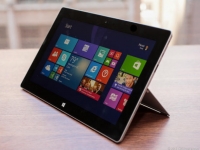
When Microsoft releases Windows 8.1 next month, there will surely be new swipe-friendly screens introduced to accommodate it -- and with good reason.
While Windows 8.1 includes some niceties for those who would rather stay in the desktop environment, Microsoft continues to stand firm on sending consumers to the Start screen with its mutated Start button and has introduced a number of enhancements to it and the Modern user interface. These include swiping down to reveal all apps, a way to select multiple Live Tiles, and support for up to three apps in resizable panes.
Following the lead of Android tablet makers and Apple, Microsoft will be enticing its hardware partners to produce smaller Windows tablets, particularly as it has left them an opening by keeping its own Surface tablets above 10 inches. We have already seen Acer jump in with the Iconia W3, along with a recent model announced by Toshiba.
The pricing waterfall among small tablets has challenges aplenty for virtually any competitor. For Microsoft, it's particularly challenging because much of what the company has put behind its tablet strategy becomes even less relevant on an 8-inch device. These include features such as support for external USB devices, keyboard docks, and Office. While Microsoft has allowed the latter to be bundled on smaller tablets, it has less appeal on a smaller tablet than on the current crop of hard-luck Windows tablets.
In short, the smaller the tablet, the less it conforms to notions of what a "PC" is and, indeed, how it's used; this throws off the company's central tablet marketing spin.
Nonetheless, small Windows tablets offer two advantages for Microsoft.
First, smaller tablets tend to be less expensive than larger ones. Although Windows tablets still won't go toe-to-toe with sub-$100 tablets at Walmart, going smaller would at least put them into iPad Mini territory. Second, without the contrivances of keyboards and other peripherals, smaller tablets are more likely to be pure slates. Because of this, there is a stronger incentive for Windows developers to support the Modern UI to reach customers using these devices. It's the flip side of the PC identity correlation.
The smaller the Windows device, the greater the relative value of touch on that device, as per Windows Phone. Indeed, rumors now persist that Microsoft will combine the app stores for Windows and Windows Phone shortly, and may even be working toward combining Windows Phone and Windows RT, the poorly received desktop Windows variant aimed at the same kind of ARM chips used in Windows Phones.
Smaller tablets are also more portable. And without many of the mobile apps shared with smartphones, the proposition for smaller Windows tablets will be weaker relative to the competition than it is for larger Windows tablets.
Still, to be a player in the tablet space, Windows has to have a presence in the middle ground between 10-inch tablets and 5-inch smartphones, even if it further tests the patience of the company and its partners. Tough love is never easy.

